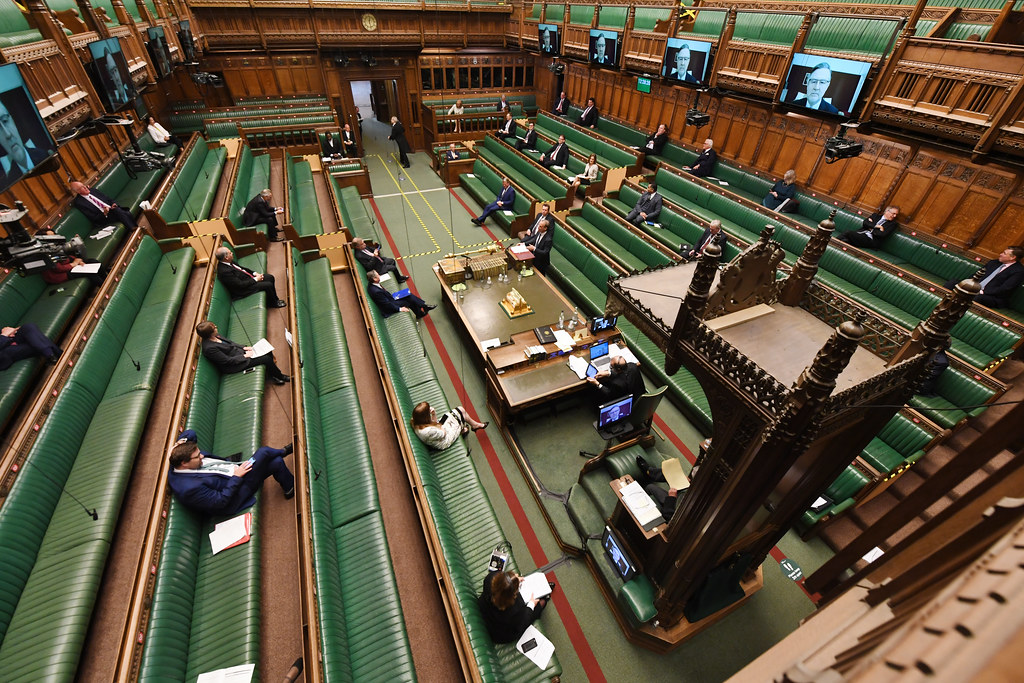While much of the world has been on lockdown, lawmakers around the world have struggled to decide whether to continue to meet or suspend their sessions. Lawmaking groups in several countries are now trying to meet virtually.
The problem with lawmakers meeting in person is fairly clear. Lawmakers meet indoors in large groups where the coronavirus could be easily spread.
Several members of the United States (US) Congress have gotten the coronavirus or were near people who had it. In the United Kingdom (UK), several members of Parliament, including Prime Minister Boris Johnson, also had COVID-19.

(Source: Pippa Fowles/Number 10 [CC BY-NC-ND 2.0], via Flickr.com.)
Online meetings are a very different way of doing business for lawmakers. Many of the important agreements made in these groups are often worked out in short, unplanned meetings during the day.
Though that kind of meeting can’t be imitated online, many of the planned meetings for these lawmaking groups, such as “hearings”, can be done virtually fairly easily.
😕
This image has not been loaded because of your cookie choices. To view the content, you can accept 'Non-necessary' cookies.
Though casual, unplanned meetings can’t be imitated online, many of the planned meetings for these lawmaking groups, such as “hearings”, can be done virtually fairly easily. Above, a screenshot taken during a virtual hearing in the US Senate.
But when full sessions of these lawmaking groups meet, it can involve hundreds of people. Figuring out who gets to speak and for how long is difficult in person. Managing it virtually is a massive challenge.
The biggest challenge is voting. Since these groups are actually creating or changing laws when they vote, it is very important to make sure that the votes are counted securely and accurately.
In the UK, the US, and Canada, lawmakers are meeting in a mix of live meetings and virtual sessions.

(Source: Jessica Taylor/UK Parliament [Parliamentary Copyright], via Flickr.com.)
In the UK, for example, only 50 members are allowed in Parliament at one time. Another 120 join in sessions over the internet. Large screens have been placed on the walls inside Parliament to allow remote members to be seen.
Many of the UK Parliament’s virtual activities, including some voting, is happening through a computer system called MemberHub. Mr. Johnson’s Conservative party is pushing for a return to real-life sessions. But many members of Parliament don’t feel it’s safe to return yet.
Canada’s Parliament has been meeting virtually over the last month. On Tuesdays and Thursdays, 338 ministers of parliament take part in a massive online meeting to question members of the government. On some other days, about 30 lawmakers meet in person to discuss special subjects.
😕
This image has not been loaded because of your cookie choices. To view the content, you can accept 'Non-necessary' cookies.
Canada’s Parliament has been meeting virtually over the last month. On some days, there is a massive online meeting. On other days, a small group of lawmakers meet in person to discuss special subjects. Above, a meeting on the coronavirus pandemic.
No new laws have been passed except for emergency spending bills. Canada is still studying how lawmakers can vote securely online. About 32 lawmakers are meeting in person today to discuss what Parliament’s virtual future looks like.
The US House of Representatives has passed a temporary rule which allows members to vote even when they’re not actually in Congress, by choosing someone to vote for them.
😕
This image has not been loaded because of your cookie choices. To view the content, you can accept 'Non-necessary' cookies.
The US House of Representatives has passed a temporary rule which allows members to vote even when they’re not actually in Congress, by choosing someone to vote for them. Above, the House rules committee discussing the new rule.
This is a huge change, and not everyone likes it. The move was passed by Democrats, with Republicans voting against the idea. House members will also be able to take part in some other activities virtually.
The US Senate is holding some hearings over the internet, but voting will still be done in person. This is easier to manage for the Senate, since it only has 100 members, compared to the 435 in the House.
Did You Know…?
In Venezuela, the National Assembly has also approved a plan to allow members to take part and vote remotely, but not because of the coronavirus. The National Assembly is controlled by lawmakers who oppose Venezuelan President Nicolás Maduro. Mr. Maduro has often tried to interfere with the lawmakers. With the rule, which was passed in December, Venezuelan lawmakers can take part in the Assembly without worrying about Mr. Maduro trying to stop them.
